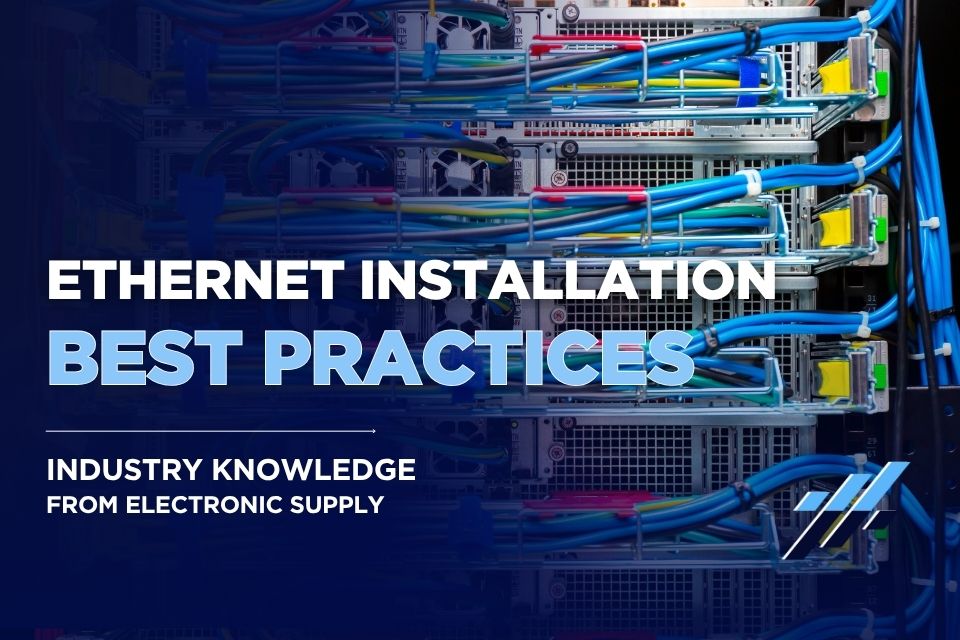As a low voltage contractor, you know that Ethernet installation is more than just running cable. The difference between a functional network and a flawless one often comes down to planning, technique, and attention to detail. Whether you’re working in a data center, outfitting a commercial space, or expanding wireless access, the stakes are high. Mistakes like improper cable routing, missing labels, or substandard terminations can lead to performance issues and expensive callbacks.
This guide delivers tactical advice for every phase of low voltage installation. You’ll learn best practices that ensure high-performance structured cabling, reduce troubleshooting time, and meet client expectations. From planning to testing, every section supports your goal of delivering reliable, professional Ethernet installations.
Understanding Ethernet Installation Fundamentals
Ethernet cabling is the backbone of most low voltage systems, supporting applications like access control, security systems, wireless access, and audio-visual integration. Structured cabling design relies on proper installation to maintain signal quality and network reliability. For low voltage contractors, understanding Ethernet standards and how they apply in different environments is key to successful network installation.
Importance of Proper Ethernet Installation
Enhances network performance and reliability
Solid installation techniques help maintain signal integrity and reduce packet loss. A well-installed Ethernet cable supports gigabit speeds or higher without degradation.
Reduces downtime and maintenance costs
Properly labeled and routed cables make network troubleshooting faster. Low voltage contractors who follow best practices see fewer service calls and happier clients.
Ensures compliance with industry standards
Conforming to NEC codes, ANSI/TIA guidelines, and manufacturer specifications ensures the installation passes inspections and maintains warranty coverage. This is especially important for structured cabling in commercial environments and data center applications.
Essential Tools and Materials for Installation
Overview of necessary tools
Standard tools for low voltage installation include:
- Cable testers (continuity and certification grade)
- Crimping and stripping tools
- Punch-down tools
- Voltage meters and certifiers
Recommended types of Ethernet cables
- Cat5e: Suitable for basic installations but becoming obsolete
- Cat6: Ideal for most business applications and access points
- Cat6a: Preferred for high-speed data center applications and long runs
Importance of quality connectors and wall jacks
Use brand-name connectors and jacks compatible with the cable category. Poor-quality components can introduce signal issues that are hard to diagnose. Low voltage contractors should always prioritize reliable hardware to support consistent network performance.
Cable Routing Techniques for Optimal Performance
Best Practices for Cable Routing
- Avoid running Ethernet near high-voltage lines to prevent electromagnetic interference (EMI)
- Maintain a bend radius of at least four times the cable diameter
- Route cables in bundles using J-hooks, trays, or conduit for clean structured cabling
- Use hook-and-loop straps instead of nylon ties to prevent overtightening
- Separate data and electrical lines when sharing wall space
In-Wall vs. Conduit Installation
Advantages and disadvantages of in-wall installations
In-wall runs are more discreet and reduce the need for surface-mounted pathways. However, they can complicate future maintenance or expansion, especially when servicing exposed low voltage wiring.
When to use conduit for Ethernet cabling
Use conduit for:
- Industrial environments with physical hazards
- Any exterior or underground installations
- Where local codes require physical protection
- Scenarios where future cable pulls are anticipated
Local building codes and regulations to consider
Codes may require:
- Fire-rated plenum cable in air-handling spaces
- Separation between low voltage and high voltage wiring
- Proper firestopping where cables penetrate walls or floors
- Specific installation methods for conduit for low voltage wiring
Effective Labeling and Documentation
Importance of Proper Labeling
Every low voltage contractor should label both ends of every Ethernet cable. It simplifies troubleshooting, supports wireless access point mapping, and accelerates changes.
Facilitates future upgrades and modifications
Labels make it easier to reroute connections, verify ports, and expand structured cabling systems without confusion. This is critical in environments with multiple access points or dynamic network configurations.
Standard labeling conventions to follow
Follow TIA-606-B guidelines for color-coding and ID format. Use weatherproof labels for outdoor or exposed low voltage wiring.
Documentation Best Practices
Keeping accurate records of installation layouts
Use marked floorplans to indicate:
- Drop locations
- Patch panel IDs
- Access point coverage zones
- Network installation routes for each segment
Utilizing software tools for network documentation
For large-scale projects, software like Visio, CAD, or network topology apps helps low voltage contractors track ports, devices, and routes. These tools are especially useful in data center or multi-building deployments.
Importance of updating documentation post installation
Document any field changes. Update cable IDs and outlet numbers. Maintain a final record for client handoff and future reference.
Wall Jack Termination Techniques
Steps for Proper Wall Jack Termination
- Strip only as much outer jacket as necessary
- Maintain twists to within 0.5″ of the termination point
- Follow T568A or T568B consistently
- Use a punch-down tool to seat wires firmly into the jack
Testing terminated connections for functionality
Test every connection using:
- Wire map testers for continuity
- Certification tools for speed and performance validation
- Visual inspection to confirm secure jack seating and cable dress
Common Mistakes to Avoid
- Over-tightening cable bundles with zip ties
- Mixing termination standards (T568A vs T568B)
- Running Ethernet too close to electrical conduit for low voltage
- Failing to plan for future network installation or access point placement
- Skipping post-installation testing or documentation updates
Conclusion and Final Thoughts
Every low voltage contractor faces the pressure of delivering installations that work reliably from day one. By following Ethernet best practices, you’ll avoid costly mistakes and build networks that stand up to modern demands. Prioritize quality materials, detailed planning, and compliance with standards.
As technologies evolve and client expectations rise, staying sharp with structured cabling and network installation techniques is critical. Whether you’re wiring a high-density data center, configuring access points for wireless coverage, or installing Ethernet cable in a small business, attention to detail is key.
For support, equipment, or expert advice on low voltage wiring and structured cabling products, contact Electronic Supply at 816-931-0250.


